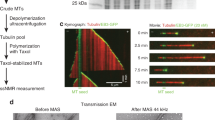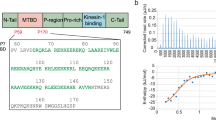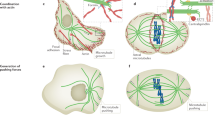Abstract
THERE is increasing evidence that several cell functions are controlled by the state of polymerisation of microtubules (MTs) and by the interaction of MTs with membranes. For example, previous studies in our laboratory have shown that colchicine-sensitive structures, presumably MTs, determine the topographical organisation of cell membrane components1–3. Conditions for the polymerisation of MTs in vitro have been described4. The MT subunit has been identified by centrifugation studies as a 6S dimer of approximately 110,000 daltons5. An additional 36S component is required for MT assembly6. The established procedures used, however, to record MT polymerisation (light scattering and viscosity measurements supplemented by negative staining and electron microscopy) do not reveal details of the interactions between subunits undergoing polymerisation and cannot be applied in the presence of elements such as membranes that contribute separately to light scatter and viscosity.
This is a preview of subscription content, access via your institution
Access options
Subscribe to this journal
Receive 51 print issues and online access
$199.00 per year
only $3.90 per issue
Buy this article
- Purchase on Springer Link
- Instant access to full article PDF
Prices may be subject to local taxes which are calculated during checkout
Similar content being viewed by others
References
Berlin, R. D., Oliver, J. M., Ukena, T. E., and Yin, H. H., Nature, 247 45–46 (1974).
Oliver, J. M., Ukena, T. E., and Berlin, R. D., Proc. natn. Acad. Sci. U.S.A., 71 394–398 (1974).
Ukena, T. E., Borysenko, J. Z., Karnovsky, M. J., and Berlin, R. D., J. Cell Biol., 61, 70–82 (1974).
Weisenberg, R. C., Science, 177, 1196 (1972).
Weisenberg, R. C., Borisy, G. G., and Taylor, E. W., Biochemistry, 12, 4466–4479 (1968).
Kirschner, M. W., Williams, R. C., Weingarten, M., and Gerhart, J. C., Proc. natn. Acad. Sci. U.S.A., 71, 1159–1163 (1974).
Forster, T. H., Disc. Faraday Soc., 27, 7–17 (1959).
Wu, C-W., and Stryer, L., Proc. natn. Acad. Sci. U.S.A., 69, 1104–1108 (1972).
Bunting, J. R., and Cathou, R. E., J. molec. Biol., 77, 223–235 (1973).
Gennis, L. S., Gennis, R. B., and Cantor, C. R., Biochemistry, 11, 2517–2524 (1972).
Shelanski, M. L., Gaskin, F., and Cantor, C. R., Proc. natn. Acad. Sci. U.S.A., 70, 765–768 (1973).
Chen, R. F., Archs Biochem. Biophys., 133, 263–276 (1969).
Lowry, O. H., Rosebrough, N. J., Farr, A. L., and Randall, R. J., J. biol. Chem., 193, 265–275 (1951).
Yguerrabide, J., Methods in enzymology, 26, Part C., 498–578, (Academic, New York, 1972).
Olmsted, J. B., and Borisy, G. G., Ann. Rev. Biochem., 42, 507–540 (1973).
Gennis, R. B., and Cantor, C. R., Biochemistry, 11, 2509–2517 (1972).
Author information
Authors and Affiliations
Rights and permissions
About this article
Cite this article
BECKER, J., OLIVER, J. & BERLIN, R. Fluorescence techniques for following interactions of microtubule subunits and membranes. Nature 254, 152–154 (1975). https://doi.org/10.1038/254152a0
Received:
Revised:
Issue Date:
DOI: https://doi.org/10.1038/254152a0
This article is cited by
-
A critical assessment of the information processing capabilities of neuronal microtubules using coherent excitations
Journal of Biological Physics (2010)
-
Cytoskeletal and muscle-like elements in cochlear hair cells
Archives of Oto-Rhino-Laryngology (1981)
-
Colchicine inhibits phosphatidylinositol turnover induced in lymphocytes by concavalin A
Nature (1977)
-
Cell surface distribution of lectin receptors determined by resonance energy transfer
Nature (1976)
-
Polymerisation of membrane tubulin
Nature (1976)
Comments
By submitting a comment you agree to abide by our Terms and Community Guidelines. If you find something abusive or that does not comply with our terms or guidelines please flag it as inappropriate.



